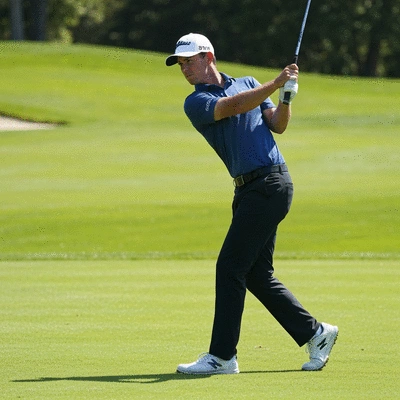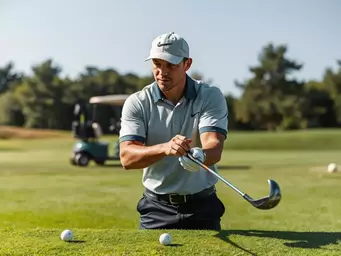Mastering Weight Shift in Golf

Are you struggling to achieve consistent power and distance in your golf swing? Understanding the crucial role of weight shift can be the key to elevating your game. Let's dive into the essential insights that will enhance your performance on the course.
What You Will Learn
- Weight shift begins with a balanced stance, crucial for effective swing mechanics.
- Proper weight transfer enhances power by engaging larger muscle groups and improving clubhead speed.
- Your center of gravity plays a vital role in maintaining stability during your swing.
- Neglecting proper weight shift can lead to injuries like lower back pain and shoulder strain.
- Incorporating warm-up exercises and flexibility training reduces the risk of injury while boosting performance.
- Maintaining a stable base and relaxed grip during your swing improves balance and control.
Key Elements of Weight Shift in Golf & Injury Prevention
This visual summarizes the critical aspects of weight shift in a golf swing, highlighting its biomechanics, impact on performance, and injury prevention strategies.
Biomechanics of Weight Shift
- Balanced stance.
- Knees and hips move in sync.
- Understanding center of gravity.
- Backswing: weight shifts to back foot.
Impact on Power & Distance
- Engages larger muscle groups.
- Enhances clubhead speed.
- Improves angle of attack.
- Transfers energy effectively.
Risks of Incorrect Transfer
- Lower back pain.
- Knee injuries.
- Shoulder strain.
- Wrist injuries.
Injury Prevention Strategies
- Warm-up & stretching.
- Core strengthening.
- Practice good mechanics.
- Maintain balance & posture.
Understanding Weight Shift in the Golf Swing
Understanding the concept of weight shift in your golf swing is essential for improving your game. It’s not just about where your weight goes; it's about how it influences your entire swing mechanics. When I first started playing, I underestimated the importance of weight transfer, but over time, it became clear that it plays a pivotal role in every successful shot.
In this section, we’ll explore the biomechanics of weight shift, its effects on power and distance, and the role of your center of gravity. These insights will provide you with a solid foundation to enhance your swing and ultimately lower your scores.

The Biomechanics of Weight Shift: What You Need to Know
At its core, weight shift involves transferring your body weight from one foot to the other during your swing. This transfer helps generate the necessary momentum to hit the ball effectively. During the backswing, your weight shifts to your back foot, which allows for a powerful downswing as you transfer it to your front foot.
To really grasp this concept, consider these key points:
- Weight shift starts with a balanced stance.
- Your knees and hips should move in sync with your weight transfer.
- Understanding your center of gravity is crucial for effective weight shift.
When you can visualize these movements, you create a pathway to better swings and improved performance on the course! Research has further explored the effect of uphill and downhill slopes on weight shift, highlighting how different terrains can influence these critical biomechanics.
How Weight Shift Affects Power and Distance in Your Golf Swing
Proper weight shift significantly influences the power and distance of your shots. When executed correctly, it allows you to transfer energy effectively from your body to the club and ultimately to the ball. Failing to shift your weight can lead to weak shots that lack distance.
Here are some ways weight shift contributes to distance:
- Generates momentum by engaging larger muscle groups.
- Enhances clubhead speed, leading to longer drives.
- Improves the angle of attack, optimizing ball flight.
When I began focusing on my weight transfer, I noticed a dramatic increase in my driving distance. It's all about finding that sweet spot where your body and equipment work in harmony! Studies have shown that optimizing weight shift in your golf swing can lead to more consistent and powerful shots.
The Role of Center of Gravity in Weight Shift Mechanics
Your center of gravity (CG) is pivotal in understanding how weight shift works. The CG is the point where your body’s weight is evenly distributed, and keeping it stable during your swing is key to maintaining balance. As you shift your weight, it’s essential to know where your CG is and how it travels throughout the swing.
Consider the following aspects when thinking about your CG:
- The CG should remain low to maintain stability.
- Shifting your weight from heels to toes can help keep the CG in check.
- Understanding your body’s CG can aid in developing personal swing mechanics.
By keeping your center of gravity in mind, you can refine your movements for a more consistent and powerful golf swing!
Pro Tip
To enhance your weight shift, practice your swing with a focus on your feet. Ensure that your weight transitions smoothly from your back foot to your front foot. A simple drill is to practice swinging while standing on one leg; this will help you develop balance and a better understanding of how your weight should shift during your swing.
Frequently Asked Questions About Weight Shift in Golf
Preventing Injuries Related to Improper Weight Shift
Golf is an incredible game that brings joy and challenge, but it also comes with its share of physical demands. When players neglect the importance of proper weight shift, they can open themselves up to a variety of injuries. Understanding these risks is the first step in safeguarding your body while enjoying the sport.
Incorrect weight transfer can lead to issues such as lower back pain, shoulder injuries, and knee troubles. When your weight shifts improperly during your swing, you might overcompensate with other parts of your body, leading to strain. It's crucial to recognize the symptoms and signs of these injuries early to prevent them from becoming chronic problems.
Understanding the Risks of Incorrect Weight Transfer
There are several key risks associated with improper weight transfer that every golfer should be aware of:
- Lower Back Pain: Incorrect weight shift can strain your lumbar spine, leading to discomfort or injury. For instance, research published in PMC NCBI discusses how biomechanical factors in the golf swing contribute to lower back pain.
- Knee Injuries: Imbalanced weight can put undue stress on your knees, resulting in sprains or joint pain.
- Shoulder Strain: Improper mechanics may cause overuse of shoulder muscles, leading to tendonitis.
- Wrist Injuries: A poor transition of weight can force you to grip the club too tightly, risking wrist strain.
By being aware of these potential issues, you can take proactive steps to improve your weight shift and protect your body on the course!

Strategies for Injury Prevention and Safe Practice
Incorporating a few injury prevention strategies into your practice routine can significantly reduce the risk of injury related to weight transfer. Here are some effective techniques:
- Warm-Up Exercises: Always start with a proper warm-up to get your muscles ready for action.
- Stretching: Focus on flexibility exercises, especially for your hips, back, and shoulders.
- Core Strengthening: A strong core helps stabilize your body during swings, promoting better weight transfer.
- Practice Good Mechanics: Regularly work on your swing mechanics with a coach or through drills that emphasize proper weight shift.
- Listen to Your Body: If you experience discomfort, take a break and assess your technique.
These strategies not only enhance your performance but also keep you playing the game you love for years to come!
The Importance of Balance and Proper Body Posture in Injury Prevention
Effective weight shift is closely linked to your balance and posture. Maintaining a stable base during your swing can help distribute weight more evenly, reducing the likelihood of injuries. Here are some essential points to consider:
- Feet Position: Keep your feet shoulder-width apart to enhance stability during your swing.
- Knees Slightly Bent: A slight bend in your knees improves balance and allows for better weight transfer.
- Upper Body Alignment: Ensure your shoulders and hips are aligned with your target for a smoother swing.
- Maintain a Relaxed Grip: Avoid gripping the club too tightly, which can cause tension in your arms and shoulders.
By focusing on these aspects of balance and posture, you’ll not only improve your swing but also protect yourself against potential injuries. As I always say, a little prevention goes a long way in this great game of golf!
Recap of Key Points
Here is a quick recap of the important points discussed in the article:
- Weight shift is crucial for generating power and distance in your golf swing.
- Maintain a balanced stance and ensure your knees and hips move in sync during weight transfer.
- Understanding your center of gravity is vital for effective weight shift and maintaining stability.
- Incorrect weight transfer can lead to injuries such as lower back pain and knee issues.
- Incorporating warm-up exercises, stretching, and core strengthening to prevent injuries related to weight shift.
- Focus on balance and proper posture to enhance your swing mechanics and reduce injury risk.









